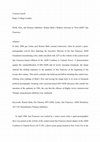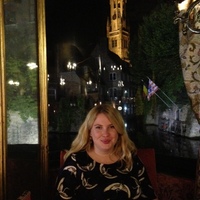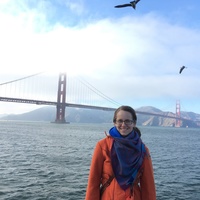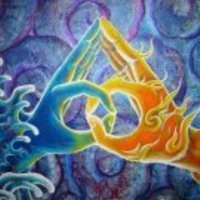Conference Presentations by Victoria Carroll

'Money Talks: Inequality and North American Identity,' 49th Parallel Conference, The University o... more 'Money Talks: Inequality and North American Identity,' 49th Parallel Conference, The University of Nottingham, June 2015.
In the middle of 2000, surrealist poet and artist Ronnie Burk caused a minor storm when he posted a pornographic activist flyer depicting the Executive Director of the San Francisco AIDS Foundation (SFAF), Pat Christen, cosseted by a mass of dollar bills and masturbating with a dildo labelled AZT, the acronym for the first patented HIV/AIDS treatment pharmaceutical, on the website of the controversial San Francisco-based chapter of the AIDS Coalition to Unleash Power (ACT UP).
This “obscene” flyer encapsulated Burk’s contempt for the shifting medical and political landscape of San Francisco (America’s “gay Mecca”) in the new millennium. As a poor, gay, Latino, HIV-positive artist, Burk had solicited the help of the SFAF in the mid-1990s, only to be sent away with a referral to a squalid hotel and some food stamps. Angry and bitter, he dedicated the next 5 years of his life to disrupting and dismantling “AIDS Inc,” an epithet used to unmask HIV/AIDS as a multinational, billion-dollar, celebrity-studded franchise, comprised of an ethically-bankrupt network of foundations, charities, ambassadors, NGOs, and pharmaceutical companies inevitably profiteering from the continued spread of HIV/AIDS.
Set against this background, this paper asks how the narrative of HIV/AIDS in North America transformed after the introduction of effective HIV treatments in 1996, moving from an emphasis on emergency outreach programs geared towards helping the sick and dying to businesses invested in making money from HIV/AIDS. Why did activists who used to scream in the streets become ensconced in a smooth-running AIDS machine, working as lobbyists, heads of policy and service groups, and even paid consultants to the drug companies they had once denounced as “AIDS profiteers”? And how did Burk’s problematic and completely overlooked cultural production obliquely emphasise the racial-national anxieties undergirding the rejuvenation of gay culture in “post-AIDS” San Francisco?
60th BAAS Conference, University of Northumbria, April 2015
Still Queer Workshop, King's College London, September 2014
59th British Association of American Studies, University of Birmingham, April 2014
Institute of North American Studies Conference, King’s College London, May 2013
58th British Association of American Studies, Exeter University, April 2013
Haciendo Caminos: Mapping the Futures of US Latino/a Literature, John Jay College, New York, Marc... more Haciendo Caminos: Mapping the Futures of US Latino/a Literature, John Jay College, New York, March 2013
Ohio State University, May 2012
Imagetext Conference, UEA, June 2011
Programs by Victoria Carroll
University of Notre Dame, London and Edinburgh, Summer 2014.
International Postgraduate Program Summer School, DAAD Funded, Mainz, Germany, Summer 2013.
The International Visitor’s Leadership Program (IVLP), Funded by The U.S. State Department’s Bure... more The International Visitor’s Leadership Program (IVLP), Funded by The U.S. State Department’s Bureau for Educational and Cultural Affairs, Summer 2012.
Teaching Documents by Victoria Carroll
King's College London Summer School, Summer 2014
King's College London, 2012-2014
King's College London, 2011
Thesis Abstract by Victoria Carroll

This project examines cultural production by gay Latinos responding to the American HIV/AIDS epid... more This project examines cultural production by gay Latinos responding to the American HIV/AIDS epidemic from 1981 to the “protease moment” of 1996, when effective medical treatments emerged. Through close readings of a wide but underrepresented range of published and unpublished literature, performance, and visual art, I argue that key groups of cultural producers accentuated blood-mixing both as a marker of Latino racial and cultural identity and as a vector of HIV transmission in this period.
Reading across Chicana feminism (a primary theoretical springboard, I argue, for modern Latino/a studies) and HIV/AIDS scholarship—two discursive contemporaries of 1990s queer theory, rarely discussed in tandem—this thesis evaluates the shaping influence of blood-mixing for Latino hybridity, queer relationality, and viral exchange. This synthesis, which I term “viral mestizaje,” proved a unique nexus for subjects identifying as both Latino and gay in the age of AIDS.
The thesis redresses several imbalances in the scholarship of HIV/AIDS and Latino/a studies in the U.S. As I argue, HIV in the bloodstreams of particular raced sexed bodies suffused cultural narratives in gay Latino communities, thereby troubling notions of racial specificity during an epidemic often labelled a “gay white man’s disease.”
I first examine abjection as an affective mechanism contouring the lived experiences of queer Latinos with HIV/AIDS. I argue that existing narratives of Latinos as racially ambiguous border-crossers paralleled and patterned rhetoric of viral transmission across spatial boundaries to disrupt the coherence of late twentieth-century identities. In the following two chapters, reaching from the East to West Coasts, I analyse the conceptual art of Felix Gonzalez-Torres and the writing of Gil Cuadros to demonstrate and deconstruct dual narratives of assimilation (as both an imperative of American cultural acquisition and a feature of viral reverse transcription) and economies of cross-racial HIV transmission. Finally, I chart the politics of memory and mythology by queer Chicano cultural producers in Los Angeles reading HIV/AIDS through the historical and mythical optics of blood-mixing and its legacies in the borderlands.
Papers by Victoria Carroll
Journal of Literary and Cultural Disability Studies, 2016
The article asks what is created when blood-mixing oscillates between a marker of Chicano/a racia... more The article asks what is created when blood-mixing oscillates between a marker of Chicano/a racial and cultural identity and a facilitator of HIV transmission. Reading across Chicano/a discourse, disability studies, and HIV/AIDS scholarship, the article evaluates the shaping influence of blood-mixing for narratives of Chicano/a hybridity, relatedness, and
reimagined kinship. This synthesis, which is termed “viral mestizaje,” proves a unique critical optic through which to revaluate blood-mixing in Chicano literature responding to HIV/AIDS.

European Journal of American Studies, 2017
In early 2000 gay Latino poet Ronnie Burk courted controversy when he posted a quasi-pornographic... more In early 2000 gay Latino poet Ronnie Burk courted controversy when he posted a quasi-pornographic activist flyer depicting the Executive Director of the San Francisco AIDS Foundation masturbating with a dildo inscribed with AZT on the website of the controversial San Francisco-based offshoot of the AIDS Coalition to Unleash Power. A demonstration against the commodification of HIV/AIDS and its newly emerging treatments, the image indexed the shifting responses to the epidemic in San Francisco at the beginning of the twenty-first century. This article considers the build-up and fallout attending this controversy, offering close readings of Burk’s flyer and tracing the image back to its roots in European political pornography, breaking with consensus-based HIV/AIDS discourse that curtails the narration of the epidemic in 1996, the year that the efficacy of Highly Active Antiretroviral Therapy using protease inhibitors was confirmed.











Uploads
Conference Presentations by Victoria Carroll
In the middle of 2000, surrealist poet and artist Ronnie Burk caused a minor storm when he posted a pornographic activist flyer depicting the Executive Director of the San Francisco AIDS Foundation (SFAF), Pat Christen, cosseted by a mass of dollar bills and masturbating with a dildo labelled AZT, the acronym for the first patented HIV/AIDS treatment pharmaceutical, on the website of the controversial San Francisco-based chapter of the AIDS Coalition to Unleash Power (ACT UP).
This “obscene” flyer encapsulated Burk’s contempt for the shifting medical and political landscape of San Francisco (America’s “gay Mecca”) in the new millennium. As a poor, gay, Latino, HIV-positive artist, Burk had solicited the help of the SFAF in the mid-1990s, only to be sent away with a referral to a squalid hotel and some food stamps. Angry and bitter, he dedicated the next 5 years of his life to disrupting and dismantling “AIDS Inc,” an epithet used to unmask HIV/AIDS as a multinational, billion-dollar, celebrity-studded franchise, comprised of an ethically-bankrupt network of foundations, charities, ambassadors, NGOs, and pharmaceutical companies inevitably profiteering from the continued spread of HIV/AIDS.
Set against this background, this paper asks how the narrative of HIV/AIDS in North America transformed after the introduction of effective HIV treatments in 1996, moving from an emphasis on emergency outreach programs geared towards helping the sick and dying to businesses invested in making money from HIV/AIDS. Why did activists who used to scream in the streets become ensconced in a smooth-running AIDS machine, working as lobbyists, heads of policy and service groups, and even paid consultants to the drug companies they had once denounced as “AIDS profiteers”? And how did Burk’s problematic and completely overlooked cultural production obliquely emphasise the racial-national anxieties undergirding the rejuvenation of gay culture in “post-AIDS” San Francisco?
Programs by Victoria Carroll
Teaching Documents by Victoria Carroll
Thesis Abstract by Victoria Carroll
Reading across Chicana feminism (a primary theoretical springboard, I argue, for modern Latino/a studies) and HIV/AIDS scholarship—two discursive contemporaries of 1990s queer theory, rarely discussed in tandem—this thesis evaluates the shaping influence of blood-mixing for Latino hybridity, queer relationality, and viral exchange. This synthesis, which I term “viral mestizaje,” proved a unique nexus for subjects identifying as both Latino and gay in the age of AIDS.
The thesis redresses several imbalances in the scholarship of HIV/AIDS and Latino/a studies in the U.S. As I argue, HIV in the bloodstreams of particular raced sexed bodies suffused cultural narratives in gay Latino communities, thereby troubling notions of racial specificity during an epidemic often labelled a “gay white man’s disease.”
I first examine abjection as an affective mechanism contouring the lived experiences of queer Latinos with HIV/AIDS. I argue that existing narratives of Latinos as racially ambiguous border-crossers paralleled and patterned rhetoric of viral transmission across spatial boundaries to disrupt the coherence of late twentieth-century identities. In the following two chapters, reaching from the East to West Coasts, I analyse the conceptual art of Felix Gonzalez-Torres and the writing of Gil Cuadros to demonstrate and deconstruct dual narratives of assimilation (as both an imperative of American cultural acquisition and a feature of viral reverse transcription) and economies of cross-racial HIV transmission. Finally, I chart the politics of memory and mythology by queer Chicano cultural producers in Los Angeles reading HIV/AIDS through the historical and mythical optics of blood-mixing and its legacies in the borderlands.
Papers by Victoria Carroll
reimagined kinship. This synthesis, which is termed “viral mestizaje,” proves a unique critical optic through which to revaluate blood-mixing in Chicano literature responding to HIV/AIDS.
In the middle of 2000, surrealist poet and artist Ronnie Burk caused a minor storm when he posted a pornographic activist flyer depicting the Executive Director of the San Francisco AIDS Foundation (SFAF), Pat Christen, cosseted by a mass of dollar bills and masturbating with a dildo labelled AZT, the acronym for the first patented HIV/AIDS treatment pharmaceutical, on the website of the controversial San Francisco-based chapter of the AIDS Coalition to Unleash Power (ACT UP).
This “obscene” flyer encapsulated Burk’s contempt for the shifting medical and political landscape of San Francisco (America’s “gay Mecca”) in the new millennium. As a poor, gay, Latino, HIV-positive artist, Burk had solicited the help of the SFAF in the mid-1990s, only to be sent away with a referral to a squalid hotel and some food stamps. Angry and bitter, he dedicated the next 5 years of his life to disrupting and dismantling “AIDS Inc,” an epithet used to unmask HIV/AIDS as a multinational, billion-dollar, celebrity-studded franchise, comprised of an ethically-bankrupt network of foundations, charities, ambassadors, NGOs, and pharmaceutical companies inevitably profiteering from the continued spread of HIV/AIDS.
Set against this background, this paper asks how the narrative of HIV/AIDS in North America transformed after the introduction of effective HIV treatments in 1996, moving from an emphasis on emergency outreach programs geared towards helping the sick and dying to businesses invested in making money from HIV/AIDS. Why did activists who used to scream in the streets become ensconced in a smooth-running AIDS machine, working as lobbyists, heads of policy and service groups, and even paid consultants to the drug companies they had once denounced as “AIDS profiteers”? And how did Burk’s problematic and completely overlooked cultural production obliquely emphasise the racial-national anxieties undergirding the rejuvenation of gay culture in “post-AIDS” San Francisco?
Reading across Chicana feminism (a primary theoretical springboard, I argue, for modern Latino/a studies) and HIV/AIDS scholarship—two discursive contemporaries of 1990s queer theory, rarely discussed in tandem—this thesis evaluates the shaping influence of blood-mixing for Latino hybridity, queer relationality, and viral exchange. This synthesis, which I term “viral mestizaje,” proved a unique nexus for subjects identifying as both Latino and gay in the age of AIDS.
The thesis redresses several imbalances in the scholarship of HIV/AIDS and Latino/a studies in the U.S. As I argue, HIV in the bloodstreams of particular raced sexed bodies suffused cultural narratives in gay Latino communities, thereby troubling notions of racial specificity during an epidemic often labelled a “gay white man’s disease.”
I first examine abjection as an affective mechanism contouring the lived experiences of queer Latinos with HIV/AIDS. I argue that existing narratives of Latinos as racially ambiguous border-crossers paralleled and patterned rhetoric of viral transmission across spatial boundaries to disrupt the coherence of late twentieth-century identities. In the following two chapters, reaching from the East to West Coasts, I analyse the conceptual art of Felix Gonzalez-Torres and the writing of Gil Cuadros to demonstrate and deconstruct dual narratives of assimilation (as both an imperative of American cultural acquisition and a feature of viral reverse transcription) and economies of cross-racial HIV transmission. Finally, I chart the politics of memory and mythology by queer Chicano cultural producers in Los Angeles reading HIV/AIDS through the historical and mythical optics of blood-mixing and its legacies in the borderlands.
reimagined kinship. This synthesis, which is termed “viral mestizaje,” proves a unique critical optic through which to revaluate blood-mixing in Chicano literature responding to HIV/AIDS.